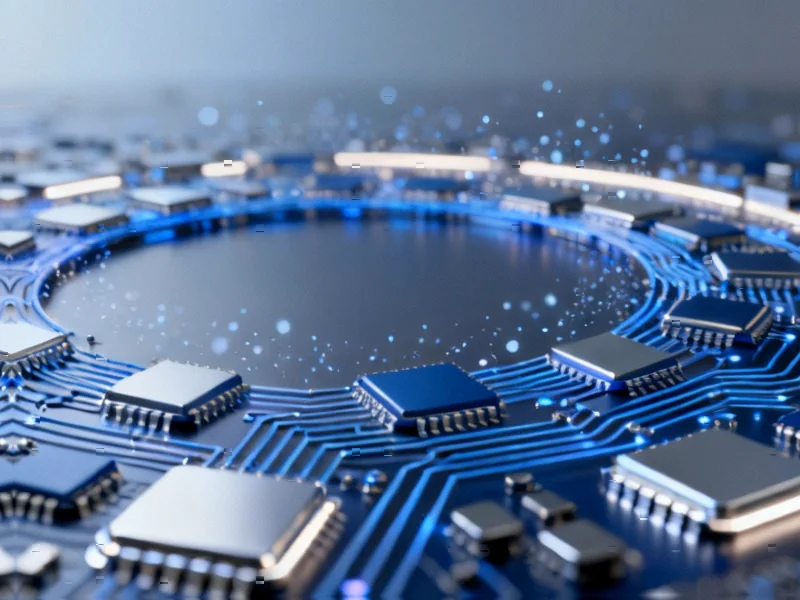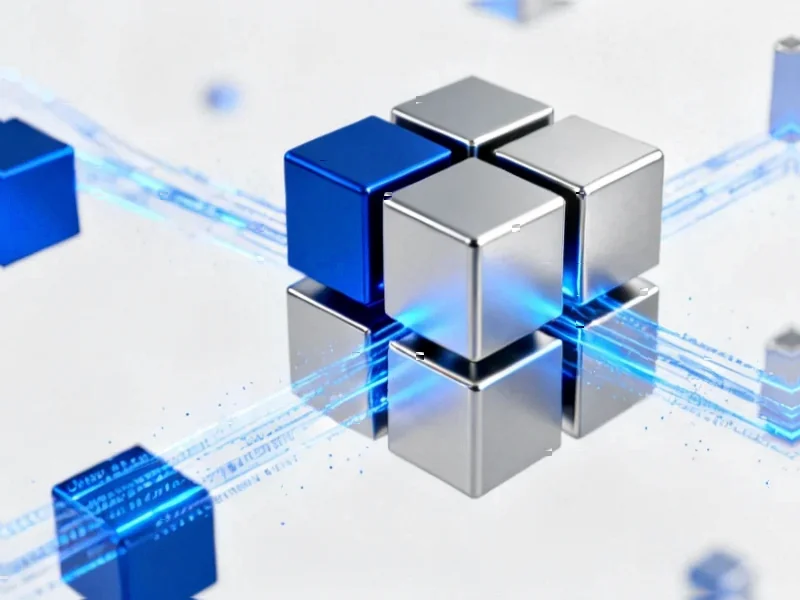While most observers focus on AI’s technological breakthroughs, the real revolution might be happening in corporate boardrooms and balance sheets. What we’re witnessing isn’t just innovation in silicon and software—it’s the emergence of a new economic model where the biggest players in artificial intelligence are building a closed-loop system that could redefine competition in the tech industry for decades to come.
Table of Contents
The Interlocking Directorates of AI
According to recent analysis, the relationships between OpenAI, Nvidia, AMD, Broadcom, and CoreWeave represent something far more strategic than traditional supplier-customer arrangements. We’re seeing the formation of what economists might call an “AI oligopoly”—a tightly knit network where capital, infrastructure, and demand circulate in a self-reinforcing loop.
The scale of these interconnections is staggering. Reports indicate Nvidia’s potential $100 billion investment in OpenAI isn’t just venture capital—it’s strategic positioning. In exchange for this massive commitment, OpenAI would reportedly build at least 10 gigawatts of data center capacity powered exclusively by Nvidia hardware. To put that number in perspective, 10 gigawatts could power approximately 7 million homes, representing an unprecedented concentration of compute power under one architectural umbrella.
Strategic Maneuvering Beyond Nvidia
What’s particularly telling is how OpenAI is simultaneously building relationships with Nvidia’s competitors while maintaining its primary partnership. The reported deal with AMD for chip supply—coupled with an option to acquire 10% equity—shows sophisticated strategic thinking. This isn’t just diversification; it’s influence acquisition. By taking a potential stake in AMD, OpenAI gains input into the chipmaker’s roadmap while ensuring a competitive alternative to Nvidia’s dominance.
Meanwhile, the Broadcom partnership takes this integration even deeper. Co-developing custom AI accelerators moves OpenAI from being a customer to becoming a co-architect of its own destiny. This arrangement echoes Google’s earlier moves with its TPU development but at a more advanced stage of market maturity. For Broadcom, embedding itself into OpenAI’s core infrastructure represents the ultimate strategic win—moving from component supplier to essential partner.
The CoreWeave Conduit
Perhaps the most revealing relationship in this network involves CoreWeave. When OpenAI signs a $6.5 billion cloud infrastructure contract with a company that runs exclusively on Nvidia hardware—and Nvidia holds a stake in that same cloud provider—the circular nature becomes undeniable. The money flows from OpenAI to CoreWeave, CoreWeave buys Nvidia chips, Nvidia invests in both CoreWeave and OpenAI, and the cycle repeats.
This creates what financial analysts might call a “virtuous circle” for participants but potentially a vicious one for outsiders. The efficiency gains are real: capital gets deployed where it’s needed most, demand becomes predictable, and integration between hardware and software improves performance. However, the barriers to entry rise exponentially when you need to compete not just with individual companies but with an entire ecosystem.
Historical Precedents and Novel Twists
We’ve seen similar patterns before in tech history. The Wintel alliance between Microsoft and Intel dominated personal computing for decades through complementary integration. More recently, Apple’s vertical integration across hardware, software, and services created a walled garden that delivered superior user experiences at the cost of ecosystem openness.
But the AI version differs in scale and complexity. The capital requirements are orders of magnitude larger—we’re talking hundreds of billions rather than millions. The interdependence runs deeper, with equity stakes, joint development, and infrastructure co-investment creating bonds that are harder to break. And the stakes are higher because we’re talking about what many consider the defining technology of our era.
The Innovation vs. Access Trade-off
The big question facing the industry is whether this closed-loop model accelerates or ultimately hinders innovation. On one hand, the certainty of demand and deep integration between software and hardware could drive faster performance improvements and more efficient resource deployment. When companies don’t have to worry about finding customers or securing supply, they can focus purely on technological advancement.
On the other hand, history suggests that closed ecosystems eventually face innovation stagnation. The telecommunications industry before deregulation, the mainframe computer market before personal computing—both show how protected markets can become complacent. The risk is that as compute, chips, and cloud capacity become concentrated within these loops, smaller innovators and research institutions get priced out or simply can’t access the resources needed to compete.
Regulatory Storm Clouds
This emerging model hasn’t escaped regulatory notice. Competition authorities in multiple jurisdictions are already examining whether these interlocking relationships constitute anti-competitive behavior. The European Commission has been particularly active in scrutinizing tech ecosystem relationships, and the U.S. Federal Trade Commission has shown renewed interest in platform power.
The legal questions are complex: When does strategic partnership cross into market division? At what point do equity stakes become mechanisms for controlling competition rather than facilitating investment? These aren’t abstract concerns—they could determine whether the AI market remains somewhat accessible or becomes the exclusive domain of a few trillion-dollar companies.
The Road Ahead: More Loops or Breaking Points?
Looking forward, this circular economy model seems likely to expand into adjacent areas. We could see similar arrangements emerging in AI data platforms, edge computing infrastructure, or even energy partnerships tied to carbon efficiency metrics. The logical extension would be for these loops to become completely self-sufficient ecosystems spanning chips, infrastructure, software, and even power generation.
However, potential breaking points exist. Technological disruption could undermine the value of these investments—if quantum computing or neuromorphic architectures leapfrog current AI approaches, the massive investments in current GPU infrastructure could become stranded assets. Regulatory intervention could force unbundling of these relationships. Or market forces could create new alliances that challenge the existing loops.
What’s clear is that the companies building artificial intelligence aren’t just creating technology—they’re engineering the economic structures that will determine who benefits from that technology for generations to come. The circular economy they’re building offers efficiency and integration, but the cost might be measured in reduced competition and limited access. As these loops tighten, the industry faces a fundamental choice: embrace the efficiency of closed ecosystems or fight for the messy but innovative chaos of open competition.
Related Articles You May Find Interesting
- Nothing’s Phone (3a) Lite Leaks Reveal Aggressive European Play
- PhotoGIMP Patch Finally Makes GIMP a Viable Photoshop Alternative for Professionals
- Apple’s AirPods Production Shift to India Signals Major Supply Chain Realignment
- Perplexity’s Comet AI Browser Security Meltdown Exposes Fundamental Flaws in AI-Assisted Browsing
- The Silent Success of IPv6: How the Internet’s Quiet Revolution Finally Arrived



